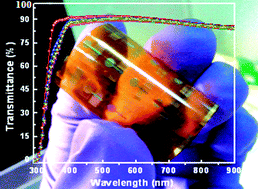Electronic displays and flexible electronics are poised to significantly impact emerging industries, including displays, energy products, sensors and medical devices, building a market that will significantly grow in the future. The implementation of transparent electronic devices requires the use of material components that could be formed using controlled deposition in the appropriate orientation onto a transparent flexible substrate. Here, we report a simple and efficient means of depositing onto a flexible polyimide (PI) substrate a highly ordered and highly aligned zinc oxide (ZnO) film for use as a carrier transporting and semiconducting layer with controlled surface charge density for thin-film transistor (TFT) applications. The deposition approach is based on the solution-coating of a zinc-acetate suspension under controlled conditions of the spread flow rate, droplet size of the drops, speed limit, and the oxygen (ca. O2) plasma treatment of the coated film surface on the PI substrate. The plasma surface interactions on the surface states of the ZnO films for various times (ca. 1–5 min) were studied using X-ray photoelectron spectroscopy and Fourier transform infrared spectroscopy. Moreover, the effects of O2 plasma and the subsequent thermal annealing in an O2 atmosphere at 250 °C on the properties of ZnO films were studied for its efficacy in TFT applications in terms of the charge carrier density and the change in the mobility. ZnO thin-film-based TFTs on PI exhibited a very high electron mobility of 22.8 cm2 V−1 s−1 at a drain bias of 5 V after treatment with O2 plasma for 2 min. Furthermore, the plasma treatment for long durations of time caused a reduction in the charge carrier density from 1.58 × 1019 cm−3 for the 2 min treatment to 1.13 × 1017 cm−3 for the 5 min treatment, and the corresponding electron mobility was changed from 22.8 and 3.1 cm2 V−1 s−1 for the treatment times of 2 min and 5 min, respectively. The spin-coating technique used to deposit very thin ZnO films is currently used in microelectronics technology, which helps to ensure that the described ZnO thin-film deposition approach can be implemented in production lines with minimal changes in the fabrication design and in the auxiliary tools used in flexible electronics production.

You have access to this article
 Please wait while we load your content...
Something went wrong. Try again?
Please wait while we load your content...
Something went wrong. Try again?


 Please wait while we load your content...
Please wait while we load your content...